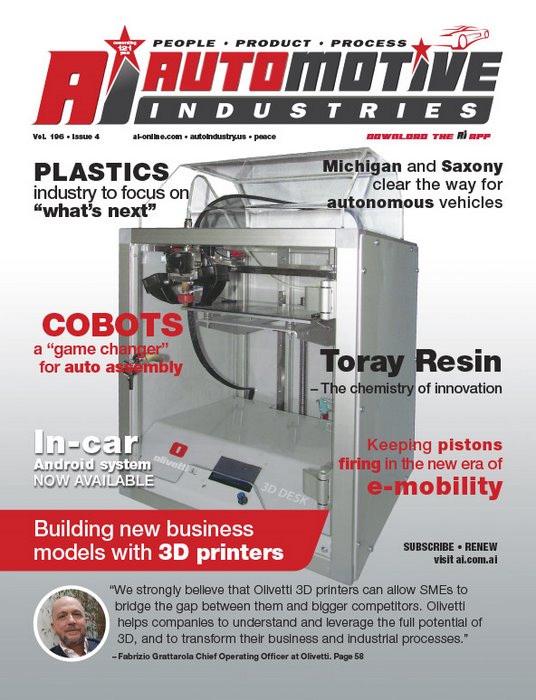
Digital printing is opening up new opportunities for small to medium-sized companies supplying the auto industry – and for those which want to break into the market.
As Olivetti says, “digital manufacturing is a worldwide key challenge to achieve the renovation and the modernization of the industry production systems”.
Automotive Industries (AI) asked Fabrizio Grattarola Chief Operating Officer at Olivetti to share some examples of how the production of automotive parts is being optimized by 3D printing.
Grattarola: Our customers operating in the automotive industry are mainly small and medium enterprises working as third party providers to the auto industry. The adoption of Olivetti S2 3D printer allows them to optimize the design/prototyping/production cycle in different ways:
Production cycles analysis and testing
An Olivetti 3D S2 printer is used to create a 1:1 scale prototype of the final product, and this model is used to analyze and test the production cycle, verifying the accuracy of dimensions, automation and movements of the robotics axes, coupling with other parts etc. It makes it possible to design and customize efficiently the configuration of manufacturing machines.
Indirect production: manufacturing tools to be used in the production phase
The 3D printer is used to produce templates to test the accuracy of the size of final products (realized with traditional standard manufacturing). Templates can reach a very high accuracy thanks to the resolution and precision of 3D printing (up to 100 micron).
Implementation of components for the final product
The Olivetti 3D S2 printer is used to produce plastic (or special materials) components like support brackets, connections, block and other parts needed for the assembly of metallic parts. 3D printing allows consistent savings of time and costs, when used for assembling parts that do not need the same physical/mechanical resistance as metal or other materials.
Pre-series production.
Olivetti S2 is used for pre-series production of rubber/plastic components to verify the technical and commercial viability of the component, by evaluating at the same time its usability “in the field” before starting the mass production using traditional methods (using molds).
AI: How does this technology help auto industry meet the new challenges it is facing?
Grattarola: The automotive industry (including motorcycles) is typically oligopolistic, being dominated by a limited number of global players and big industrial groups. However, a very large number of SMEs operate in the same industry as designers, producers and specialized service providers for components, instruments, tools and accessories that are incorporated by the car makers. Many are specialized in aftermarket products, or operate as aftersales maintenance networks or as niche players in specific areas like car racing. In most of these areas customization is often needed, and this is where there are large market opportunities for the Olivetti 3D printers.
We strongly believe that Olivetti 3D printers can allow SMEs to bridge the gap between them and bigger competitors. Olivetti helps companies to understand and leverage the full potential of 3D, and to transform their business and industrial processes.
AI: How is IoT connected to the 3D printing solutions, and what are the implications for the automotive industry?
Grattarola: The 2018 range of 3D printers, Olivetti S2 and 3Ddesk (a smaller size printer), can be connected locally using Wifi but also remotely using an embedded M2M cellular module. This will allow a seamless secure connection to the cloud, without needing to connect through the company’s local area network.
This will enable new IoT service and business models. In particular, remote and predictive maintenance plans can be provided, as the printer will transmit constant data about its state and usage. The monitoring of these parameters allows companies to optimize the duty cycle of the 3D printer as there will be minimal downtime. A connected IoT 3D printer also enables new business models like 3D-printing-as-a-service, which will lower the barriers to high tech technology for many customers.













More Stories
Some Ways How Motorists End Up in Collisions at U-Turns
Maximise Margins with Proven PPF Tactics
Finding the Car Boot Release Button – Tips and Tricks